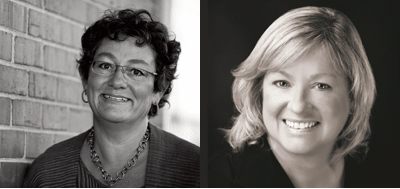 |
| Annette Stelmack, Bridget Conway |
|
By Liz Switzer
Interior designer and self-described “ecogeek” Annette Stelmack, lecturer and author of “Sustainable Residential Interiors,” wants her audience to know two things:
1. Green design is not a formidable or difficult undertaking; and
2. Building has become a more collaborative, holistic process because of the green synergy that results from building teams coming together on LEED projects.
Interior designers now play a more integral role than ever in the business of building. They come to the table as equal team players with architects, engineers and construction project managers, and sustainability has had a lot to do with that.
“As interior designers, we have a huge role in the safety, health and welfare of our clients,” said Stelmack, who lectures at conferences and teaches courses on the subject for the American Society of Interior Designers (ASID). “Whether it is commercial, hospitality or residential, we serve our clients in such a way that it is our responsibility to know what the important issues of the day are as well as the future. Sustainability is absolutely at the top of the list.”
One of the questions Stelmack is often asked is whether green is just a trend. Answer: Far from it. “Sustainability has become a way of life to the point where it has completely integrated with all of the credits in interior design programs at all levels and integrated in higher education curriculum.”
Sustainability may have started as a trend, but it has become a definitive lifestyle for the customers of designer Bridget Conway, principal of Lighthouse Interiors in Lighthouse Point, Fla. Conway has been an interior designer for some 20 years in South Florida, a region of the country that has long been concerned with ecological conservation and energy use. She has also seen her professional role expand through sustainability over the course of her career.
Both Conway and Stelmark work closely with architects on matters like sighting building locations to minimize energy costs, placement of interior light sources and landscaping. LEED v3, the most recent version of the U.S. Green Building Council’s rating system, has mandated specialty areas for green building professionals that will strengthen the collaboration process further, the designers said.
But both women said the biggest green concern that designers deal with now is indoor air quality. “People have become much more aware of sustainable design, and homeowners are looking for a house that is comfortable and certainly affordable but also healthy to live in,” Conway said. “They look at their health from a more holistic approach, and it is more important that their homes be friendly to their bodies. When you are the one making the decisions not only for your own home, you have a responsibility to be aware of what’s going on and try to help in any way you can.”
Volatile organic compounds or VOCs in flooring products is one of those concerns. VOCs are regulated through LEED, but sustainable projects — while on the increase — still represent a small percentage of the total number of building projects. So Stelmack communicates to designers that healthy flooring is now readily available and can be easily incorporated into any design whether a project is LEED-rated or not.
Wood flooring is preferred these days by both designers as a sustainable and aesthetically pleasing flooring choice. While Conway has installed a lot of marble and stone over the years, she now sees a preference for wood.
“Wood floors are our most sustainable commodity,” she said. “In the tropics, we love the exotic woods but we are going away from that so we use products such as Anderson’s Exotic Impressions because it is forested in a sustainable way. We love wood and the choices we have are just endless.”
One challenge designers face is educating their clients on the plethora of sustainable products on the market and substances used in the manufacturing process, installation and maintenance. Those choices can be difficult or confusing to make, said EcoTimber Northwest regional sales manager Pam Meehan, who also has a background in design.
But designers and the public are becoming more educated about the ecological aspects of material, and with wood that is a lot to consider, Meehan said. “There are more user-friendly price points on sustainable goods, too, and that is helping,” she said. “Most of the products we sell are very comparable to other products on the market in price.”
Education for Stelmark has become a major focus of her work. She has collaborated with both the ASID and the U.S. Green Building Council to put together green workshops and recently presented a white paper at
NeoCon about eco-friendly residential products and how they fit sustainable requirements, another question she is often asked.
“Sustainable design is not difficult,” she said. “It’s really just taking one room, one product at a time, and understanding how you qualify and integrate those products into your design process. Sustainability is here to stay, and I really believe that in five years it will be completely engrained in interior design and architectural business as normal practice.”